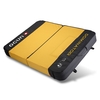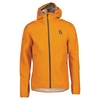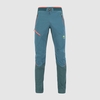Tommy Caldwell and Alex Honnold: the great Fitz Roy traverse interview

 1 / 7
1 / 7 Tommy Caldwell / Alex Honnold
Tommy Caldwell / Alex Honnold
"It’s basically going camping on the most amazing mountains in the world" Honnold explains in this interview, but his humour evidently hides all the difficulties and uncertainties of an ascent of this magnitude. As well as the phenomenal preparation required to pull it off. And so, after having succeeded in taking things one step further time and time again on the big walls in Yosemite, the two have now applied their experience and training to this immense traverse. Making, as it happens, the most of the only real good weather window that this rainy austral summer has offered so far...
Before talking about the beautiful traverse, how did you hear about Chad Kellogg who died on Fitz Roy while you were out in the mountains? What were your thoughts?
Alex: We were all out there for the same weather window. I heard about it on the afternoon of our return. We’d both fallen asleep as soon as we got back to our house and woke up when some friends came over to check in on us. They broke the bad news. I’d only met Chad down here on this trip, but all of our friends here had known him for years so the whole community has been a bit shaken. Seems like one of those terrible random accidents. Super bad luck.
Tommy: The death of Chad Kellog is a real tragedy that put the climbing scene down here in real turmoil. We lost a good friend and I think it gave us all pause about the dangers of mountain climbing.
Alex: from your recent Sendero Luminoso solo to the Fitz Roy traverse… the difference is clear, less so how you experienced it though.
Alex: Obviously there is a big difference in style, but at the heart of it they are both just big rock climbing adventures. And actually, the whole time I was in Potrero working on Sendero I kept joking about how it was good Patagonia training. We went up on Sendero something like 8 times in 9 days to clean, practice, solo and film the route. That’s actually pretty similar to spending 5 days in a row climbing all day along a ridge.
How did the idea of this traverse come about. It’s not something you decide on the spur of the moment, right?
Tommy: The traverse has been one of the low hanging fruits in Patagonia for a long time. It was one of the most obvious and beautiful objectives down here. The skyline we traversed is the Patagonia logo and many teams have attempted it over the past decade. Having said that, we came down here with many possible objectives in mind, we figured we would just climb whatever was in condition. Due to the particularly wet and cold summer the Torres were covered in rime. The traverse seemed like a relatively good option because much of the climbing is on north faces that tend to clean off the quickest. The weather window was of adequate size so we went for it. I also like the idea of big climbs. And this is about as big as they come.
Alex: Tommy had mentioned it to me before the trip and it seemed like an obvious possibility for us since it suits our strengths. But honestly we were sort of flexible, we'd considered a bunch of other objectives and were open to anything, it just depended on the weather. And thankfully we got a big enough weather window so it made sense to try the whole traverse.
Alex, we were under the impression you don’t have a great ice climbing background. Tell us how things went.
You are under the correct impression. I basically have no experience ice or snow climbing and I’ve never led ice at all. But that’s what Tommy was for! And the route is almost entirely rock, so it wasn’t a huge problem. But the few snow and ice traverses were definitely the scariest parts for me.
Tommy: were you worried about Alex’s background in any way?
I don't have a ton if ice climbing experience either. But I do have enough experience to make it safe and to know that it usually isn't super hard. In Patagonia if you are willing to suffer a bit and only turn around when absolutely necessary, you can get up a lot of things.
You’ve always been super fast in your ascents. So tell us what it was like to travel together for 5 full days.
Tommy: It was just kind of a bigger scale version of what we have done in the past with a few more variables thrown in. We had big packs that made us climb quite a bit slower than we were used to. But our ability to simul climb through relatively hard terrain and climb 5.11 in approach shoes, gloves and packs were the key to making this happen for us.
Alex: It felt the same as our one day ascents, but 5 of them in a row. It’s crazy how long the traverse is - even though we were moving pretty quickly compared to normal standards it still felt like we were crawling. It’s just really far.
What were the biggest difficulties? Did all go according to plan?
Tommy: Our plan was pretty loose. We packed light, but with enough gear for four full days of climbing. We had no experience on the traverse so we gathered as much beta from Rolo's book and then just went for it.
What was the weather like and conditions on the mountain?
Alex: The weather was glorious. We couldn’t have asked for better. Perfect calm sun. Conditions were decidedly more mixed, with pretty much every route having sections of icy crack. We did a lot of improvisation, swinging around wet/icy parts and figuring things out as we went. I think this was the first good weather window of the whole season, so there was a lot of accumulated snow and rime. Not that I know much about it since I’ve never been here before. . .
Just one sleeping bag for the two of you… so how does this work?
Tommy: We had a wedge that we zipped into the bag to make it big enough for two people. We had no pads so the sleeping was not great. Probably an average of three of four hours a night for me. We did bring a Firstlight tent. This made things much more comfortable that they would have been otherwise.
Alex: yes, the wedge makes the bag wider and it was actually relatively comfortable, though next time we would probably just take two super light bags. But I didn’t have a super light bag because I’ve never done this kind of alpinism. We didn’t sleep a lot anyway, so it wasn’t a huge issue.
Alex, we know you like reading. Had you read any books about Patagonia beforehand and what did you expect?
I’ve been reading all environmental books - I prefer to read about the wider world outside of climbing. But I’ve had so many friends spending so much time here over the years that I had a decent idea what it would be like. If anything, Patagonia has been more impressive than I expected.
We saw the short list of gear. Did you regret not having taken something with you? Or did you regret having taken something?
Tommy: I would have taken more tape and some hand cream. Wet cold gloves and rough rock took a pretty big toll on my hands.
Alex: We had more food than we expected, but that was kind of nice. Otherwise we pretty much nailed it on the packing I think. Tommy wanted lotion/skin cream just because his skin was cracking. But basically we were fine. One of my favorite sayings is "if you don’t have it, you don’t need it."
If you have to describe the ascent to alpinists, what would you say? And how can you compare it to other ascents?
Tommy: It's pretty hard to compare this ascent to others. And I am not really an alpine climber so I don't know how it stacked up in terms of alpine climbing. I do know though that we dealt with a lot of icy cracks and the Headwall after the north pillar on Fitz Roy felt very alpine (a bit outside my comfort zone).
Alex: I would compare it to something like the Grand Traverse in the Tetons, but on steroids. Or a much more extreme version of the big Sierra traverses. I’ve never really done anything quite like it though, since it combines big wall climbing, ice climbing, ridge traversing, etc. It’s a little bit of everything. I would just say that it’s 5 days of technical ridge climbing. Or probably 4 days if someone does it with slightly better conditions and better beta. We kept calling it an extremely scenic backpacking trip. It’s basically going camping on the most amazing mountains in the world.
Alex, one thing you missed during this traverse compared to your solos? Was this the sort of adventure that was missing from your list and why?
This traverse was just so different than soloing. We were mostly climbing in gloves and approach shoes, just for comfort, and we had big packs on. Compared to the freedom of soloing it was a bit ridiculous really. But in terms of overall life experience it was probably more than any small solo can offer. We felt really out there for a full 5 days, which is a long time to really dive into a project. Even long solos only take a few hours, so you don’t get that total immersion. It was a great experience for me.
Tommy & Alex: ritual question: what was it like climbing with each other? Positive and Negative aspects!
Alex: I don’t think I could have done this with anyone but Tommy really. It’s really important to trust your partner and know that he’s super solid on this kind of terrain, and since Tommy and I have already climbed together a fair amount I think it was a perfect background for this kind of adventure.
Tommy: Climbing with Alex was incredible. I really couldn't imagine having done it with anyone else. We laughed the whole time, morale was great. And being tied into the rope with a super talented rock climber gave me the confidence to move fast.
Just to comprehend the adjective"epic" you used for the ascent, can you give us just one reason why you’d do this climb again?
Tommy: I probably wouldn't plan on doing this one again. It took quite a toll on my body. Only now that five days have passed since we returned to El Chalten is my body starting to feel like normal again.
Alex: Yeah, I don’t know if I would do this again either... I’d rather do a new traverse. The Cerro Torre Traverse looks amazing...
Yes, you're right. Last thing: anything we've missed?
Alex: May I just also add a big thank you to Rolando Garibotti and Colin Haley, who were super helpful in all our planning and even gave us their aluminum crampons and water along the way. They were both really supportive of our effort, even though they’ve wanted to do the same traverse for a long time. I think it’s really classy that they helped us out so much despite wanting to climb the same objective. Big thanks!
- two backpacks (35 and 25 liters)
- one sleeping bag
- a BD First Light tent
- a stove and three gas canisters
- one ice tool
- two pairs of aluminum crampons
- one ice-screw
- 2 each Camalots to #2
- 1 Camalot #3
- two sets of Stoppers
- a 60m 9.8mm lead line
- an 80m 6mm tag line
- three ascenders/locking pulleys (Petzl Micro-traxion, Kong Duck and Futura)
- 6 quick-draws
- 14 slings
| Expo.Planetmountain | |
| Expo The North Face | |
| www | |
| www.pataclimb.com | |
| Tommy Caldwell Facebook | |
| Alex Honnold Facebook | |
| www.alexhonnold.com | |



 Copia link
Copia link

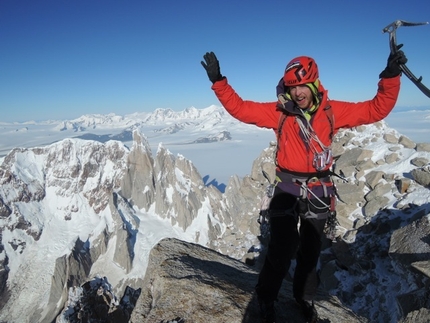
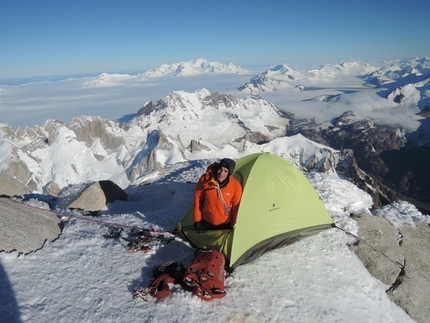
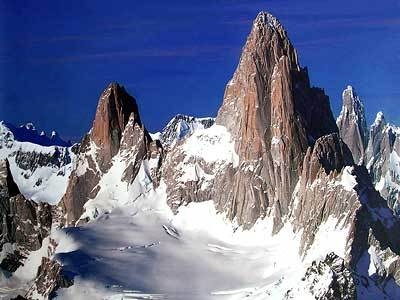
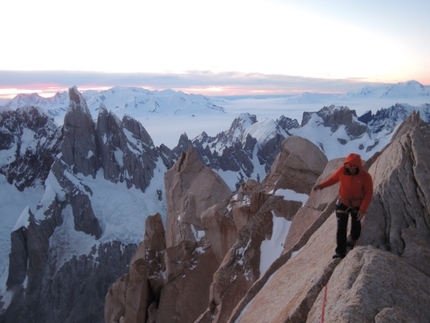
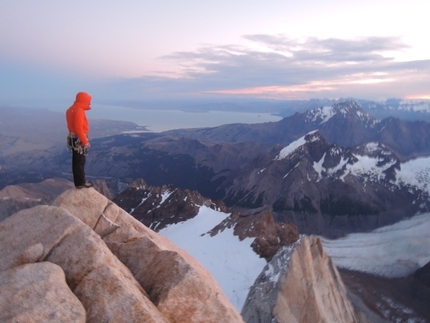
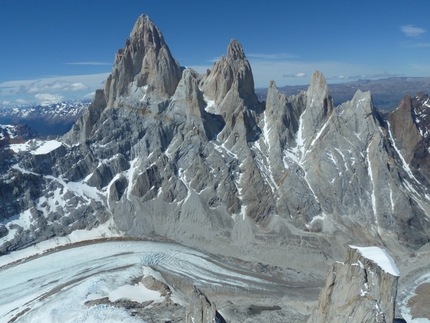
 See all photos
See all photos











